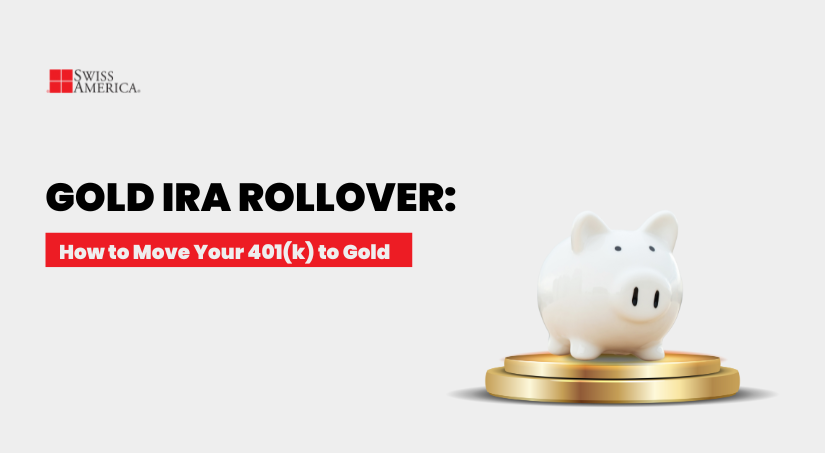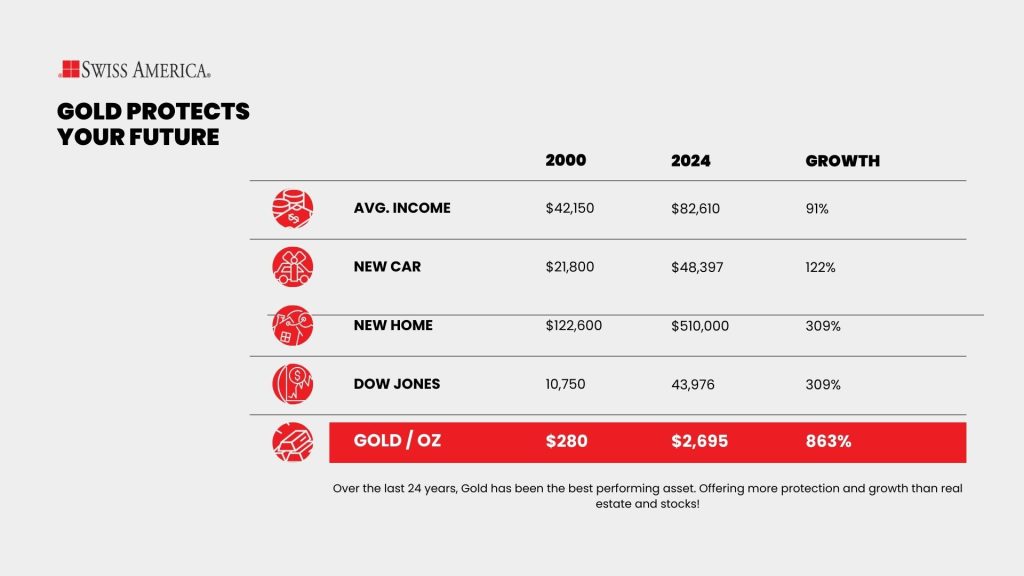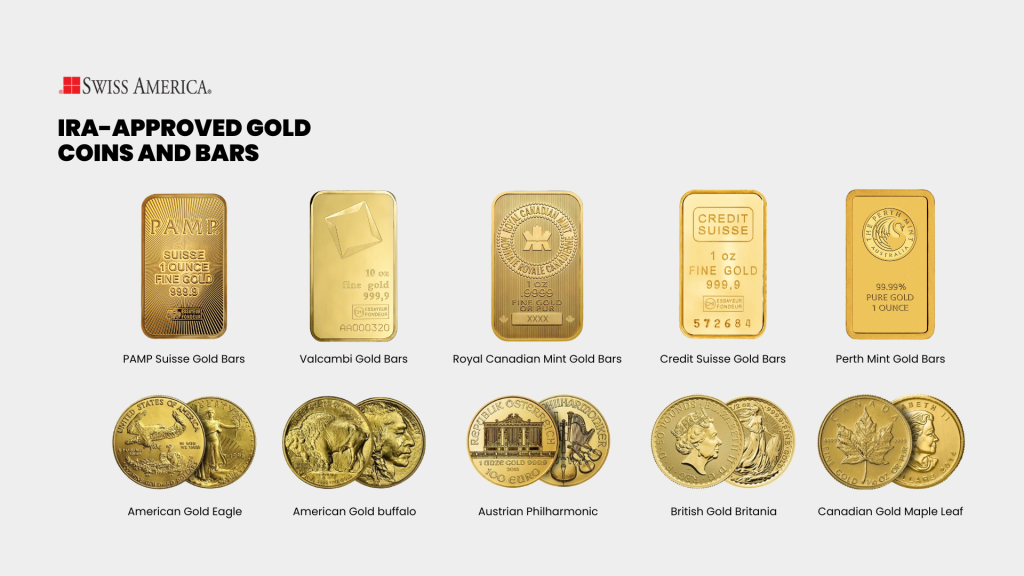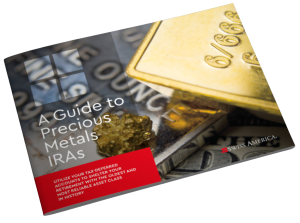
One of the most effective ways to hold gold is by doing a Gold IRA rollover. This is an easy process that gives you a way to diversify your retirement savings while also benefiting from tax advantages.
Gold is a defensive investment that people buy when they’re worried about the current environment or what might happen in the future. As of this writing, gold’s spot price is around $3,300/ounce, and JP Morgan Chase predicts it will reach over $4000/oz by the second quarter of 2026.
A Gold or precious metal IRA is one of the best approaches to adding gold to your retirement plan and helping protect your wealth.
What is a Gold IRA rollover?
A Gold IRA rollover is when you move retirement funds into a self-directed IRA that allows you to buy gold, silver, and other precious metals. This specialized individual retirement account gives you more control over your investments so that you can hold tangible assets instead of just paper-based ones.
You can do this with accounts like a traditional IRA, an old 401 k from a previous employer, or a Roth IRA. A Gold IRA is separate from a traditional retirement account, but the tax rules and contribution limits remain the same.
Why consider a Gold IRA rollover?
Some of the reasons why people purchase gold for their retirement plan include:
Diversification and hedge against inflation
Many people open a Gold IRA account to protect against inflation. When inflation rises, the value of paper currency drops, and your money buys less. Gold tends to move in the opposite direction.
As the dollar weakens and prices climb, investors move their money into assets that feel safer and more stable. Gold fits that role because it’s a tangible asset with a limited supply, and that scarcity helps support its value over time.
So instead of watching inflation slowly chip away at your retirement savings, owning physical metals gives you a way to hold something that increases in value when everything else gets more expensive.

Safe haven asset in volatile times
Many people think of physical gold as a safe haven asset because investors turn to it during uncertain times. When the stock market gets rocky or there’s fear around interest rates, inflation, or global conflict, gold can hold steady or even climb. Investors see owning gold coins or bars as a way to protect their money when other assets feel unpredictable.
Consider the past several years:
Global Financial Crisis (2008–2012): During this recession, investors fled the stock market, and gold nearly doubled in value while many other asset classes collapsed.
COVID-19 Pandemic (2020): People panicked in the early months of the pandemic, and the stock market saw steep declines and volatility. Meanwhile, gold rose by 24% and reached an all-time high of $2,075/oz by mid-2020.
Current scenarios: Gold is up over 60% in the past year because of geopolitical tensions, trade wars, continued inflation, depreciation of the US dollar, and economic uncertainty.
| Period | Gold Price Peak (Approx.) | Date | Key Drivers |
| Global Financial | $1,825 | August 01, 2011 | Recession and European sovereign debt crisis |
| Pandemic | $2,000+ | August 01, 2020 | COVID-19 market volatility and global stimulus |
| Current | $3,359 | July 01, 2025 | Trade tensions and inflation risks |
Tax advantages
One of the benefits of a Gold IRA is that it gives you tax-deferred growth while holding a physical asset like gold and silver. If you use a traditional IRA, you won’t pay taxes until you take distributions in retirement. If you have a Roth IRA, you pay taxes upfront, but your qualified withdrawals later on are completely tax-free.
Either way, your gold can grow in value inside the account without triggering yearly taxes, which gives you the chance to build long-term value in something tangible.
Risks and drawbacks of Gold IRAs
Gold is a defensive asset. It doesn’t pay dividends and may not grow wealth as effectively as traditional investments like stocks and bonds over the long term. This is why your financial advisor likely recommends keeping a smaller portion of your retirement savings in gold.
Other drawbacks to consider are:
Fees and storage costs
When you hold physical gold in your retirement account, there are a few costs to keep in mind. You’ll usually pay a premium over the spot price when you buy, and there can also be fees for account setup, annual maintenance, and storage.
You’ll also need to keep your physical precious metals in an IRA-approved depository that has ongoing storage costs. These can range from $100-$150 per year for commingled storage.
Liquidity and required minimum distributions
If you have a traditional Gold IRA, the IRS requires you to take minimum distributions once you reach the age of 73. To do this, you’ll either need to sell some of your precious metals for cash or take what’s called an in-kind distribution, where your custodian ships the physical metals directly to you.
If you go with in-kind, you’ll pay ordinary income taxes on the fair market value of your precious metals at the time of your withdrawal.
Pitfalls to avoid
There are a few things to watch out for when setting up a Gold IRA account. First, make sure you’re buying the right kind of gold. Collectible coins and gold jewelry don’t qualify and can cause problems with IRS rules.
You also can’t store your gold at home because the IRS requires you to store it in an approved depository.
And finally, avoid scams by working with a Gold IRA company that’s been in business for decades and has great reviews. They should also provide educational materials to help you understand gold and other precious metals investing.
Eligible accounts and rollover rules
Some of the IRS regulations and rules you need to know about an individual retirement account IRA that allows you to own gold are:
Which retirement accounts qualify?
You can move retirement savings into a Gold IRA from a range of qualified accounts. These include:
- Traditional IRA
- Roth IRA
- SEP IRA
- SIMPLE IRA
- Old 401(k) accounts from a previous employer
- 403(b), 457(b), or Thrift Savings Plans (TSP)
IRS regulations to know
There are a couple of important IRS rules to remember when rolling over funds into a physical Gold IRA.
If you do an indirect rollover and take possession of your retirement savings, you have 60 days to deposit that money into your new IRA. Missing that deadline means the IRS treats it like a withdrawal. Also, be aware of retirement age details. The IRS considers IRA money invested in collectibles, like physical gold, as an immediate distribution, subjecting it to taxes and penalties.
You can only do one IRA-to-IRA rollover every 12 months. This rule applies across all your IRAs, not per account. So if you’ve done one already this year, you’ll need to wait before doing another, or use a direct transfer instead.
IRS-approved metals
The IRS has rules about what kinds of metals you can hold inside a physical Gold IRA. These include requirements around purity and where the metals come from.
Here’s what qualifies:
Purity
- Gold: The gold coins or bars you buy must be at least 99.5% pure.
- Silver: The silver you hold in your self-directed IRA must be at least 99.9% pure.
- Platinum and palladium: Both platinum and palladium coins or bars must be at least 99.95% pure.
Sources
The metals also have to come from an approved source. These include national government mints or refiners accredited by NYMEX, COMEX, LBMA, or a similar group.
Condition
Your precious metals also must be in good condition, in their original packaging, and include certificates of authenticity.
Example IRA approved gold
Some common examples of IRS-approved gold coins include the American Gold Eagle, Canadian Maple Leaf, and Australian Kangaroo. Note that the IRS doesn’t allow you to hold collectibles or numismatic coins inside precious metals IRAs.

401(k) to Gold IRA rollover steps
There are four simple steps to rolling over your retirement savings into a Gold or precious metals IRA:
Step 1: Open a self-directed IRA account
Work with a specialized IRA custodian to open your Gold IRA account. This isn’t your typical brokerage. Precious metal custodians handle IRS reporting, help you stay compliant with rules, and work with your gold dealer to buy and sell gold on your behalf.
Look for a custodian who has experience with precious metals and is transparent about fees and timelines.
Step 2: Transfer your retirement savings
Move money from your existing IRA, 401(k), or other qualified retirement account into your new self-directed Gold IRA. There are two ways to do this:
- Direct rollover: This is the simplest and best option. The financial institution responsible for your current plan sends your retirement funds straight from your account to your new IRA custodian. You don’t touch the money, and that means you avoid taxes and penalties.
- Indirect rollover: In this scenario, the administrator sends the funds to you first, and then you have 60 days to deposit them into your new IRA. If you miss that deadline or get the process wrong, the IRS may treat it as a distribution, which means taxes and possibly a 10% penalty if you’re under 59½.
Step 3: Purchase IRS-approved gold and silver
Work with your gold dealer to decide on which bars and coins you want to buy. Once you’ve chosen, you’ll direct your custodian to buy the metals on your behalf.
Step 4: Securely store your metals
Your gold dealer ships your metals to an IRS-approved facility per the directions from your custodian. There are two main storage options:
Commingled: With commingled storage, your metals get stored in a shared vault space with other investors’ assets. This approach has lower storage fees.
Segregated: This option means your exact gold bars or coins reside in their own space, separate from other holdings.
With either option, the depository is in charge of securing and insuring your metals under IRS guidelines.
Gold IRA tax implications
Many of the rules about Gold or precious metals IRAs are the same as they are for traditional IRA accounts:
Rollover tax treatment
If you follow the right process, there are no taxes when you do the rollover itself.
Contributions
The annual contribution limits for gold IRAs are the same as those for traditional IRAs. For 2026, these are $7,500 or $8,600 for individuals aged 50 or older.
Taxes for traditional vs Roth Gold IRA
Traditional Gold IRA: With this type of retirement account, you don’t pay taxes while your gold grows in the individual retirement account. Instead, you pay regular income tax when you start taking money out in retirement.
Roth Gold IRA: You pay taxes on this type of account before the money goes in, but once it’s in the account, your gold can grow, and you can take withdrawals later, completely tax-free.
It really comes down to timing. Do you want to pay taxes now or later?
Taxes on withdrawals
When it’s time to withdraw money from your Gold IRA, you can sell the metals and take a cash distribution, or you can take an in-kind distribution and have the physical gold shipped to you.
If you have a Traditional Gold IRA, the value of the metals you withdraw gets taxed as ordinary income. With a Roth Gold IRA, your withdrawals are completely tax-free as long as you’re at least 59½ and the account has been open for five years.
Costs and fees of Gold IRAs
It’s always a good idea to understand the fee structure and costs associated with any investment.
Account setup and admin fees
When you open a Gold IRA, there’s usually a one-time setup fee and yearly fees to keep the account running. These fees cover things like account maintenance, IRS reporting, and communication between your custodian and precious metals dealer.
Always ask for a breakdown of what’s included so you don’t have surprises later.
Storage and insurance fees
Besides storage fees for either commingled or segregated storage, you’ll also want to understand the insurance coverage. IRS-approved depositories include insurance as part of their service, but the amount and scope can vary.
Make sure you confirm what’s covered, how claims work, and whether there are any extra charges for higher-value holdings.
Markups on metals
Markups are the difference between the market price of gold or silver and the retail price you pay. Every precious metals dealer adds a markup to cover costs and provide service. This is standard in the industry.
The amount depends on the product, demand, and how much you’re buying. Reputable dealers like Swiss America provide upfront details on pricing and what you’re paying for.
How to choose a reputable Gold IRA company
Here’s what you should look for if you plan to set up a Gold IRA:
Dealer credentials
Work with a firm that has decades of experience and a long-standing reputation in the precious metals industry. Also, look for membership in trade groups like the Industry Council for Tangible Assets (ICTA) or the American Numismatic Association (ANA). These memberships show a commitment to standards and accountability.
Fee and policy details
The Gold IRA company should be transparent about its fees. That includes setup, account maintenance, storage, and buyback policies. The best Gold IRA companies will give you all this information upfront, without hidden terms buried in fine print.
Customer reviews
Check verified customer reviews on the company’s website, Google reviews, and the Better Business Bureau. Be sure to look at how the company responds to issues to get a sense of its customer support.
Is a Gold IRA rollover right for you?
Owning physical gold in an IRA gives you a great way to diversify your retirement savings and benefit from tax advantages. It can help you offset stock market volatility and provide some defense against inflation and future crises.
Check out our free Gold IRA kit to learn more about how to invest in gold as part of your retirement strategy or connect with the Swiss America team today!
Gold IRA Rollover: FAQs
Can I roll my 401k into gold without penalty?
Yes, you can roll over your 401k without taxes and penalties. The best route is to use a direct rollover, in which your current plan administrator sends a check directly to your self-directed IRA custodian.
How do I liquidate my Gold IRA?
You can sell your gold to a gold dealer. Get a quote from the dealer and then let your custodian know you want to sell. They’ll ship your metals to the dealer to verify authenticity, and your dealer then provides the funds to the custodian. From there, you can keep the money in your IRA or take it as a distribution.
Is it better to buy physical gold or a Gold IRA?
It depends on your goals. If you’re looking to add physical gold to your retirement portfolio, using an IRA gives you the tax advantages that come with it. But if you’re not focused on holding physical gold inside an IRA, you can always buy it outright with extra funds you have available.
The information in this post is for informational purposes only and should not be considered tax or legal advice. Please consult with your own tax professionals before making any decisions or taking action based on this information.
